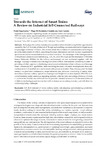Towards the Internet of Smart Trains: A Review on Industrial IoT-Connected Railways

Use este enlace para citar
http://hdl.handle.net/2183/19467Colecciones
- Investigación (FIC) [1685]
Metadatos
Mostrar el registro completo del ítemTítulo
Towards the Internet of Smart Trains: A Review on Industrial IoT-Connected RailwaysFecha
2017-06-21Cita bibliográfica
Fraga-Lamas, Paula; Fernández-Caramés, Tiago M.; Castedo, Luis. Towards the Internet of Smart Trains: A Review on Industrial IoT-Connected Railways. Sensors, 2017, vol. 17, no 6, p. 1457.
Resumen
[Abstract] Nowadays, the railway industry is in a position where it is able to exploit the opportunities created by the IIoT (Industrial Internet of Things) and enabling communication technologies under the paradigm of Internet of Trains. This review details the evolution of communication technologies since the deployment of GSM-R, describing the main alternatives and how railway requirements, specifications and recommendations have evolved over time. The advantages of the latest generation of broadband communication systems (e.g., LTE, 5G, IEEE 802.11ad) and the emergence of Wireless Sensor Networks (WSNs) for the railway environment are also explained together with the strategic roadmap to ensure a smooth migration from GSM-R. Furthermore, this survey focuses on providing a holistic approach, identifying scenarios and architectures where railways could leverage better commercial IIoT capabilities. After reviewing the main industrial developments, short and medium-term IIoT-enabled services for smart railways are evaluated. Then, it is analyzed the latest research on predictive maintenance, smart infrastructure, advanced monitoring of assets, video surveillance systems, railway operations, Passenger and Freight Information Systems (PIS/FIS), train control systems, safety assurance, signaling systems, cyber security and energy efficiency. Overall, it can be stated that the aim of this article is to provide a detailed examination of the state-of-the-art of different technologies and services that will revolutionize the railway industry and will allow for confronting today challenges.
Palabras clave
IoT
IIoT
Internet of trains
Railway safety
Rail planning and scheduling
Predictive maintenance
WSN
Railway enhanced services
Freight transportation
Cyber security
IIoT
Internet of trains
Railway safety
Rail planning and scheduling
Predictive maintenance
WSN
Railway enhanced services
Freight transportation
Cyber security
Versión del editor
Derechos
Atribución 3.0 España
ISSN
1424-8220
1424-8239
1424-8239






